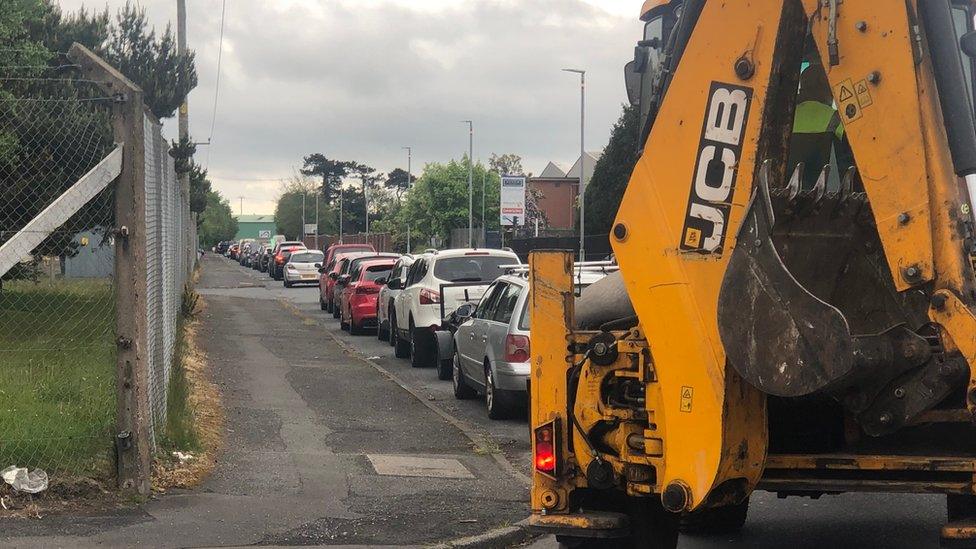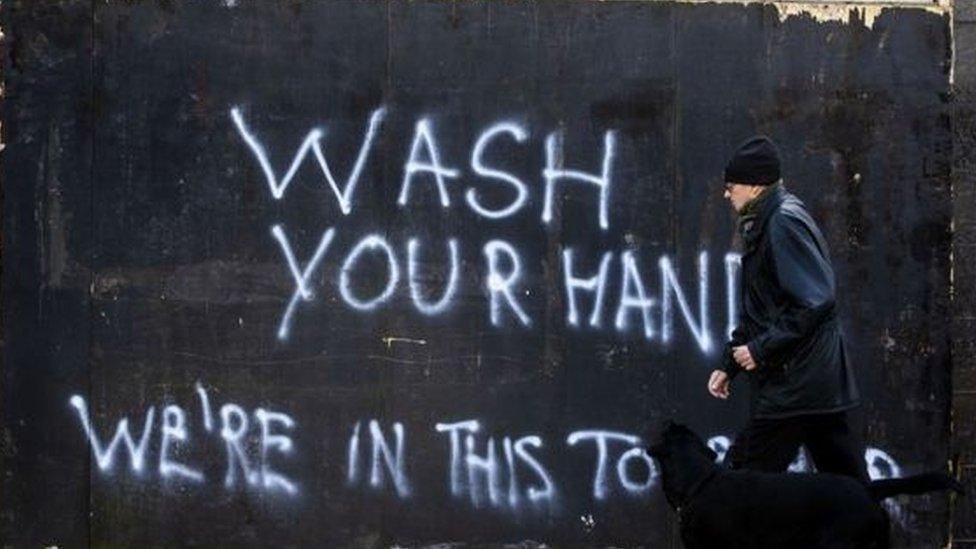Coronavirus: Garden and recycling centre centres reopen as NI lockdown plan debated
- Published
- comments

Queues are developing at household recycling centres across Northern Ireland - this photograph was taken this morning in Bangor
Garden centres and recycling centres in NI can reopen from today, as part of the first steps to ease lockdown.
Marriage ceremonies where a person is terminally ill are also allowed.
Last week, the executive published a five-phase blueprint for lifting restrictions but it did not include a timeframe.
Ministers have been meeting to decide whether the latest scientific advice means other restrictions can be lifted.
On Monday, the Department of Health announced six more Covid-19 related deaths, external in Northern Ireland, bringing its total to 482.
The deaths all happened since Sunday.

The department's figures mostly comprise hospital deaths and where a patient had tested positive for the virus.
A separate weekly report from the Northern Ireland Statistics and Research Agency (Nisra) shows that 599 deaths had been recorded, up to 8 May as its figures record all fatalities where coronavirus is mentioned on a death certificate.
The executive has said it will be guided by scientific and medical advice before it agrees to lift any further lockdown restrictions.
Lengthy queues
Last Thursday, it agreed to lift a small number of restrictions beginning from 18 May, which also includes the reopening of angling facilities across Northern Ireland.
The first and deputy first ministers warned that the relaxation could only happen if social distancing was followed, but stressed that not all aspects of the first step of their recovery plan will take effect at once.
Some recycling centres, which are managed by Northern Ireland's 11 councils, had already put safety measures in place and reopened ahead of the executive's announcement last week.
There have been lengthy queues at some centres that reopened this morning, with Derry City and Strabane District Council appealing, via social media, for people to put their journey off until later in the day.
Allow X content?
This article contains content provided by X. We ask for your permission before anything is loaded, as they may be using cookies and other technologies. You may want to read X’s cookie policy, external and privacy policy, external before accepting. To view this content choose ‘accept and continue’.
Agriculture Minister Edwin Poots said the executive had received scientific advice about the easing of further measures at "short notice", ahead of its meeting last Thursday.
While the advice suggested other elements of step one of the pathway to recovery could be implemented, some ministers wanted more time to consider the changes, he added.
'It's nice to get out in the fresh air again'
Infrastructure Minister Nichola Mallon defended the executive's decision not to release all the restrictions scheduled in step one of the plan at once.
"It was about recognising that people need to have things very clearly communicated to them, we need to be minimising confusion and that's where there was discussion around the executive table," she said.

Pathway to recovery
Step one:
Encouragement to those unable to work from home to return to work on a phased basis
Large outdoor-based retail can open including garden centres, though associated cafes and restaurants can only offer takeaway or collection
Groups of four to six people who do not share a household can meet outdoors maintaining social distancing. With the exception of people who are shielding, visits to immediate family allowed indoors where social distancing is possible
Drive-through church services and churches open for private prayer, with appropriate social distancing and cleaning of shared contact hard surfaces
Outdoor spaces and public sport amenities to open. For example, some water activities, golf, tennis
Drive-in cinemas can open

Lockdown easing not without risk

It is understandable that some ministers have reservations about lifting more restrictions - after all, no decision they take is without risk.
Easing too much in one go could push up that all-important R-number, which measures the average rate of transmission. And that could result in the executive having to re-impose lockdown measures.
This remains a balancing act for an executive that was not even two months in office when the pandemic began.
Ministers insist it's not a matter of health versus wealth - but there is a concern, particularly from some businesses who would much prefer a timetable to work to, that moving too slowly will hit the local economy even harder.
While the executive as a whole defended the plan it published last week, the task of choosing which bits to enforce - and when - will continue to split ministers.

The Republic of Ireland begins phase one of its recovery plan on Monday.
People will be allowed to meet outdoors in small groups of up to four, but social distancing must be observed.
Gardeners and repair staff who are mainly based outdoors can return to work, and outdoors-based retailers can reopen.
Why does the R-rate matter for lifting lockdown?
The R-value - or reproduction number - is at the heart of the executive's decision to keep the lockdown in place, until at least the end of May, only lifting a small number of measures that bring the least risk.
'R' refers to the average number of people that someone with Covid-19 is expected to infect after contracting the virus.
The goal is to keep R under one.
Last week, Mrs Foster said the R-rate in Northern Ireland was sitting at "below 0.7", falling from between 0.8 and 0.9 in the previous two weeks.
The Department of Health said the R-rate is calculated mostly on intensive care occupancy and hospital admissions, but that care home cases have essentially "no impact" on it.
The executive's Chief Scientific Adviser Prof Ian Young has said the R-number in care homes across Northern Ireland is "significantly above 1.0 at the moment".

EASY STEPS: How to keep safe
A SIMPLE GUIDE: What are the symptoms?
CONTAINMENT: What it means to self-isolate
HEALTH MYTHS: The fake advice you should ignore
MAPS AND CHARTS: Visual guide to the outbreak
VIDEO: The 20-second hand wash

- Published12 May 2020

- Published12 May 2020
- Published20 October 2020
